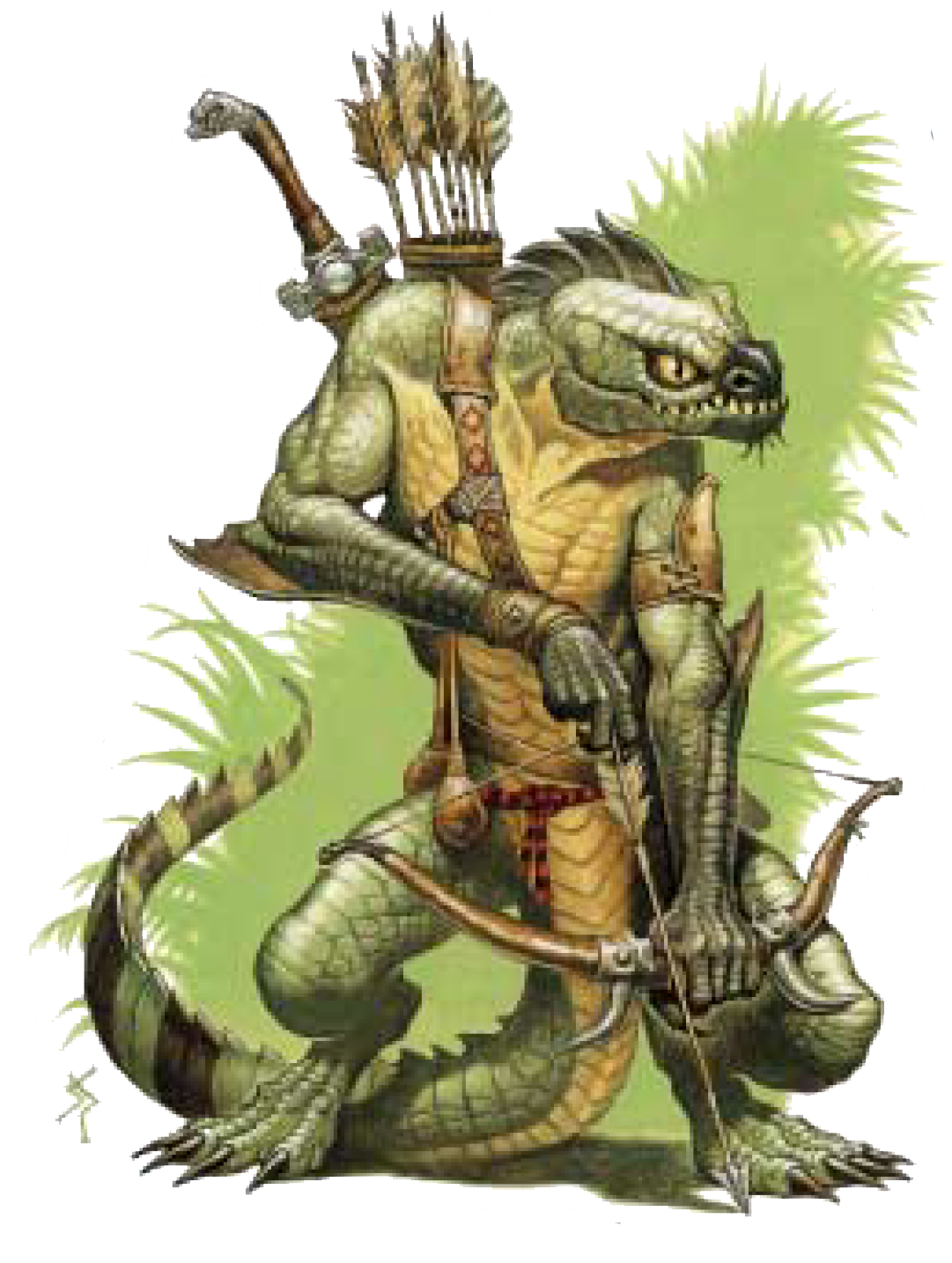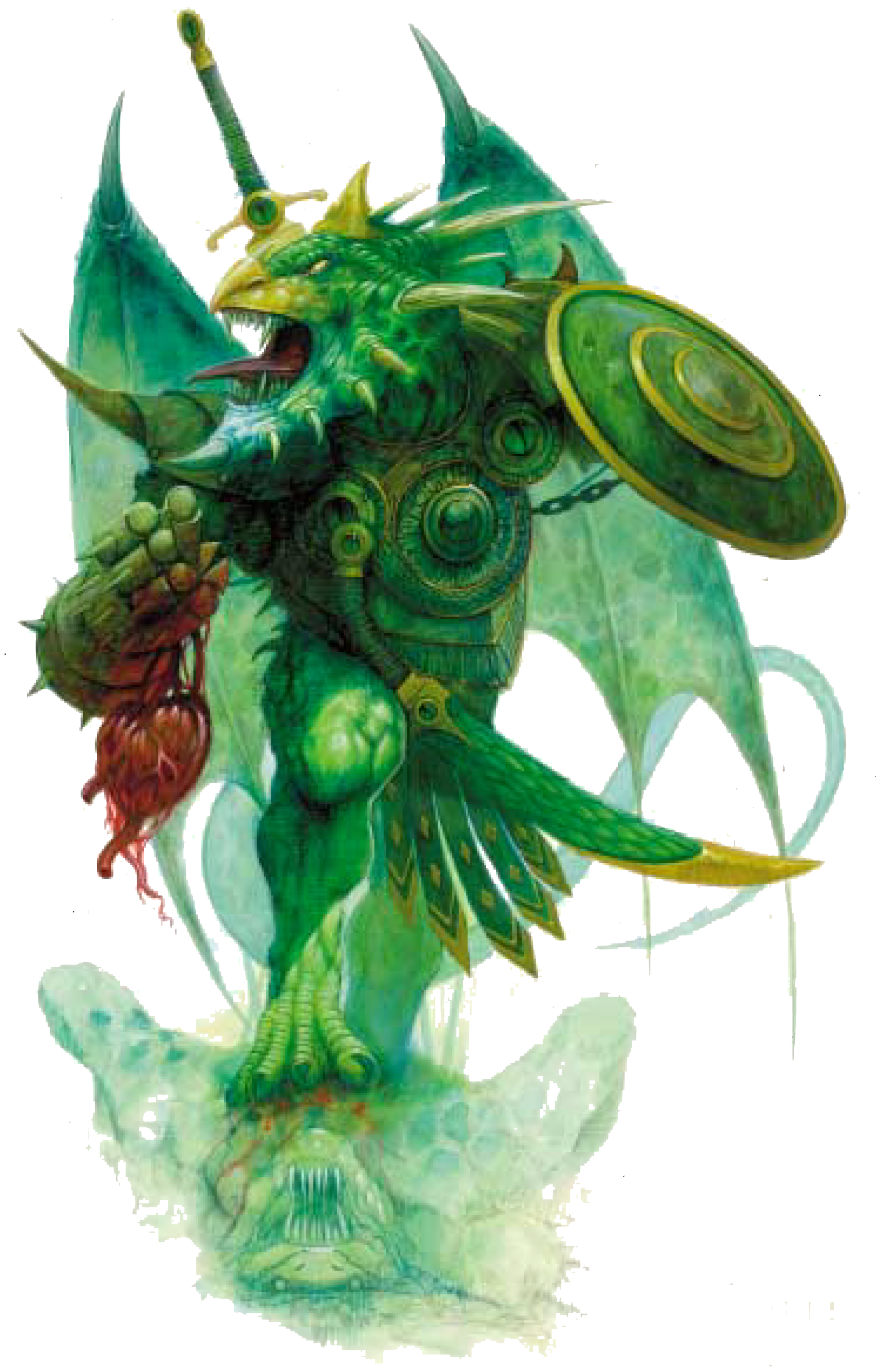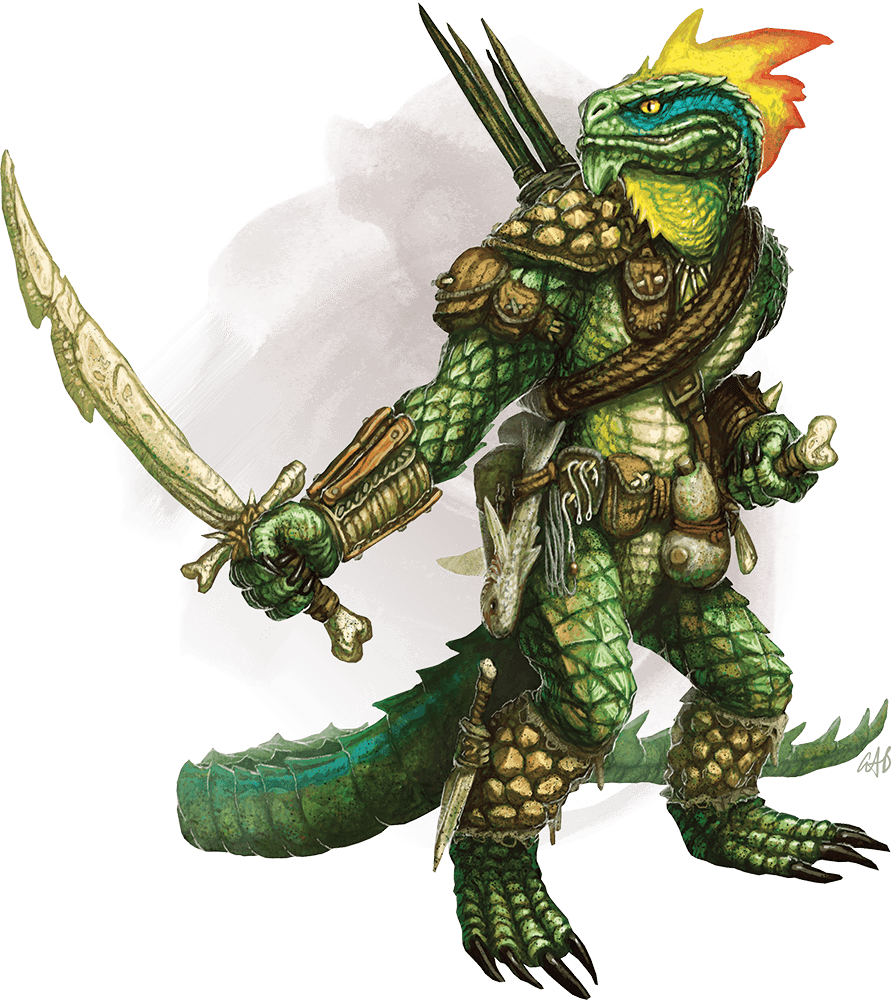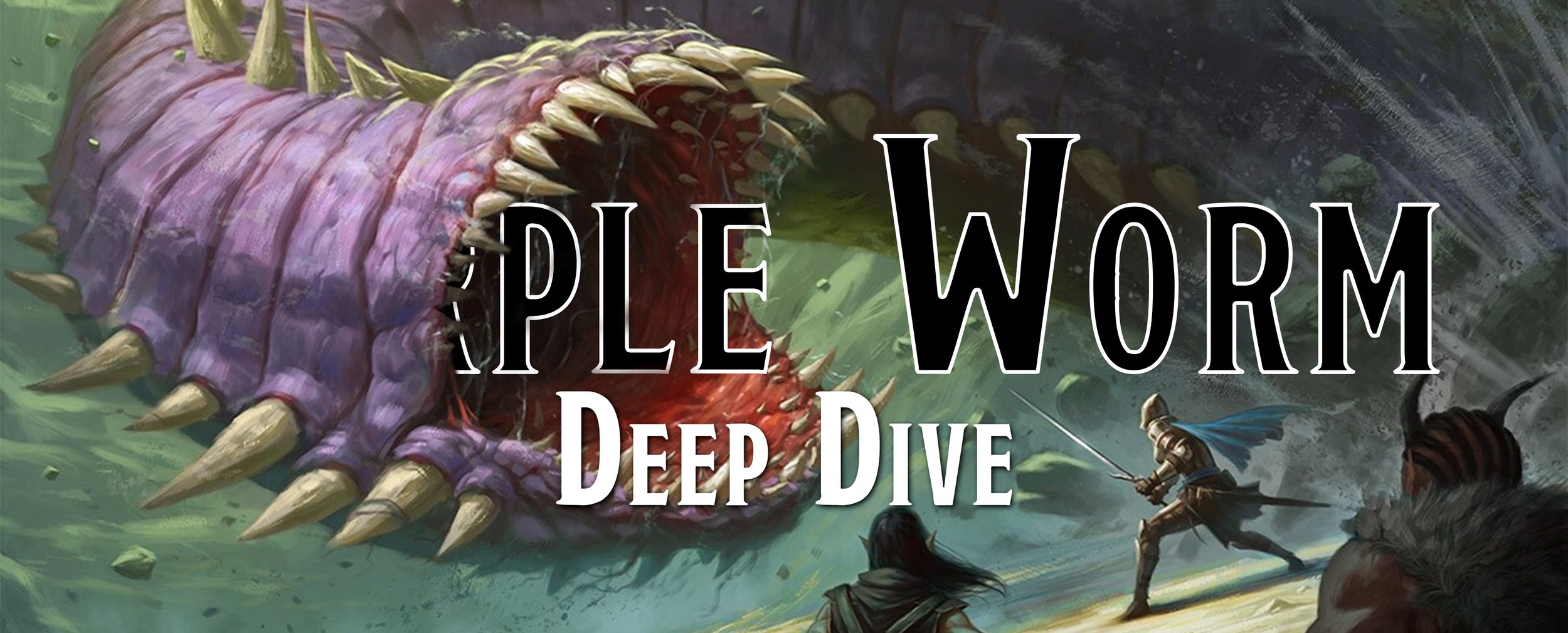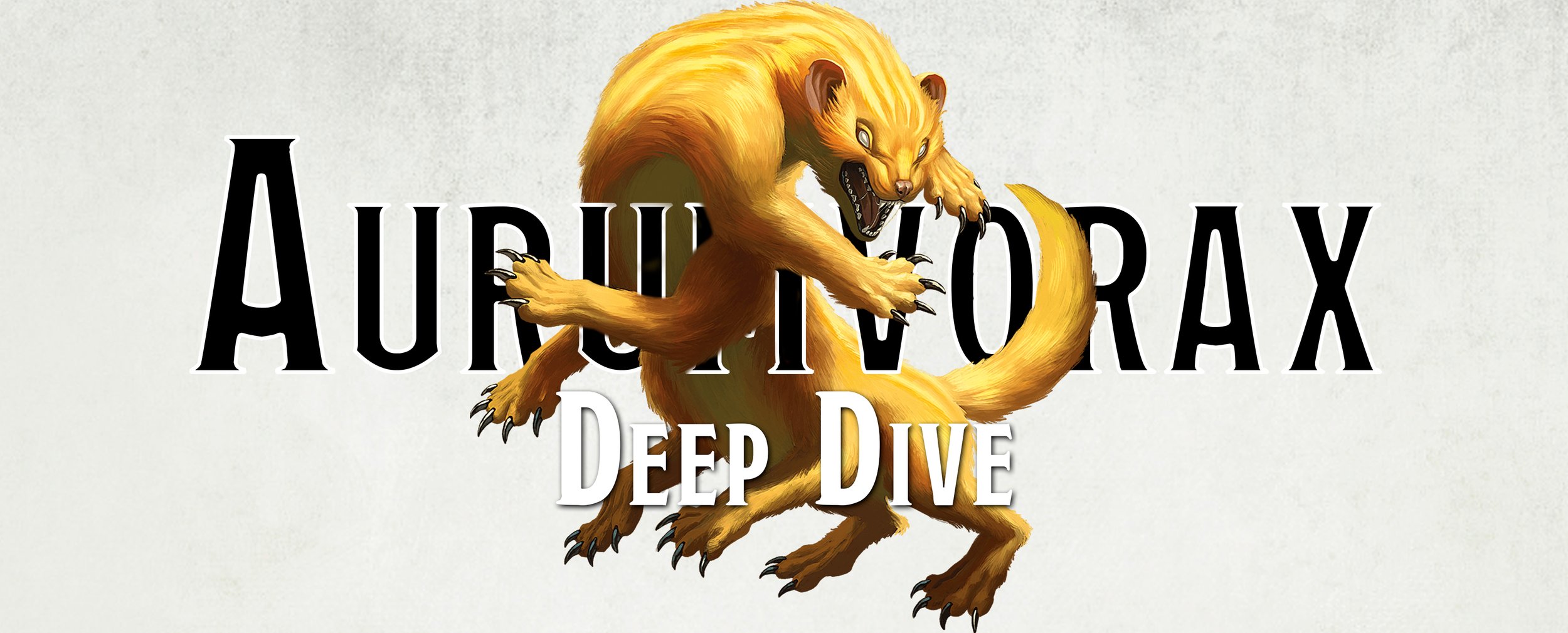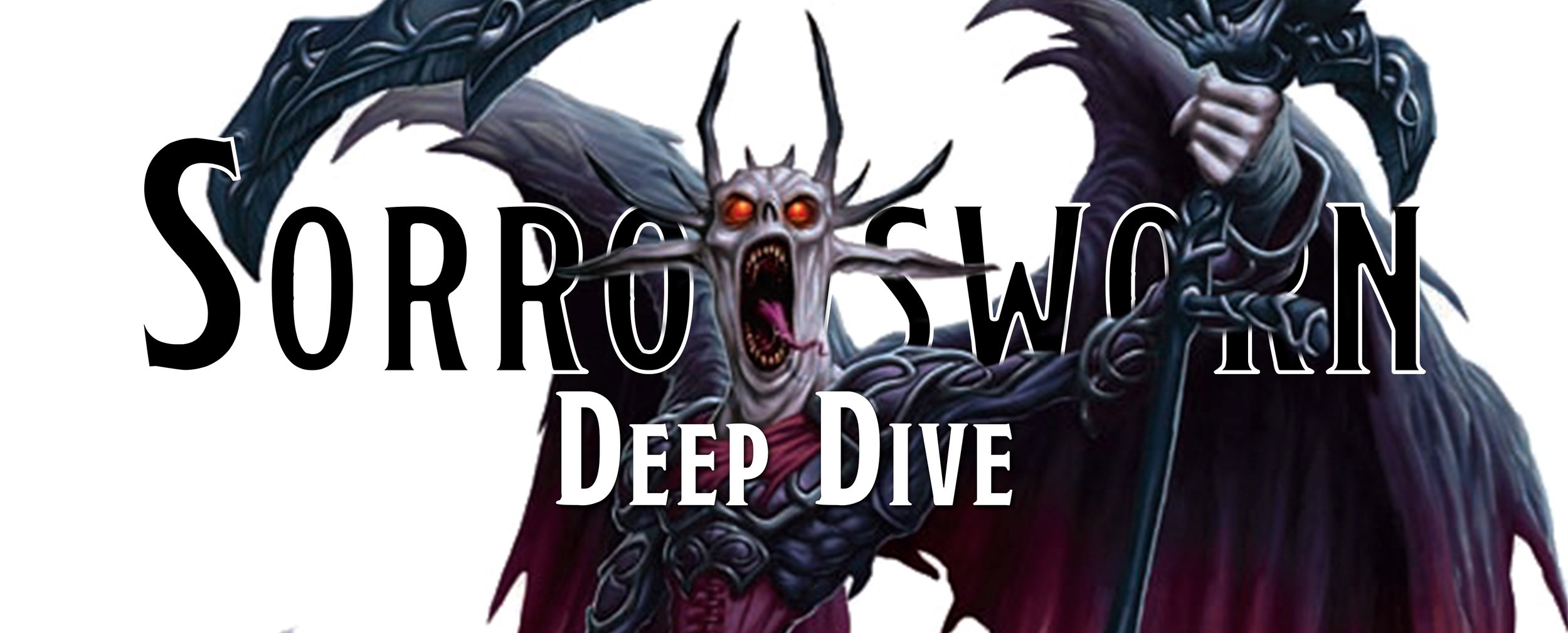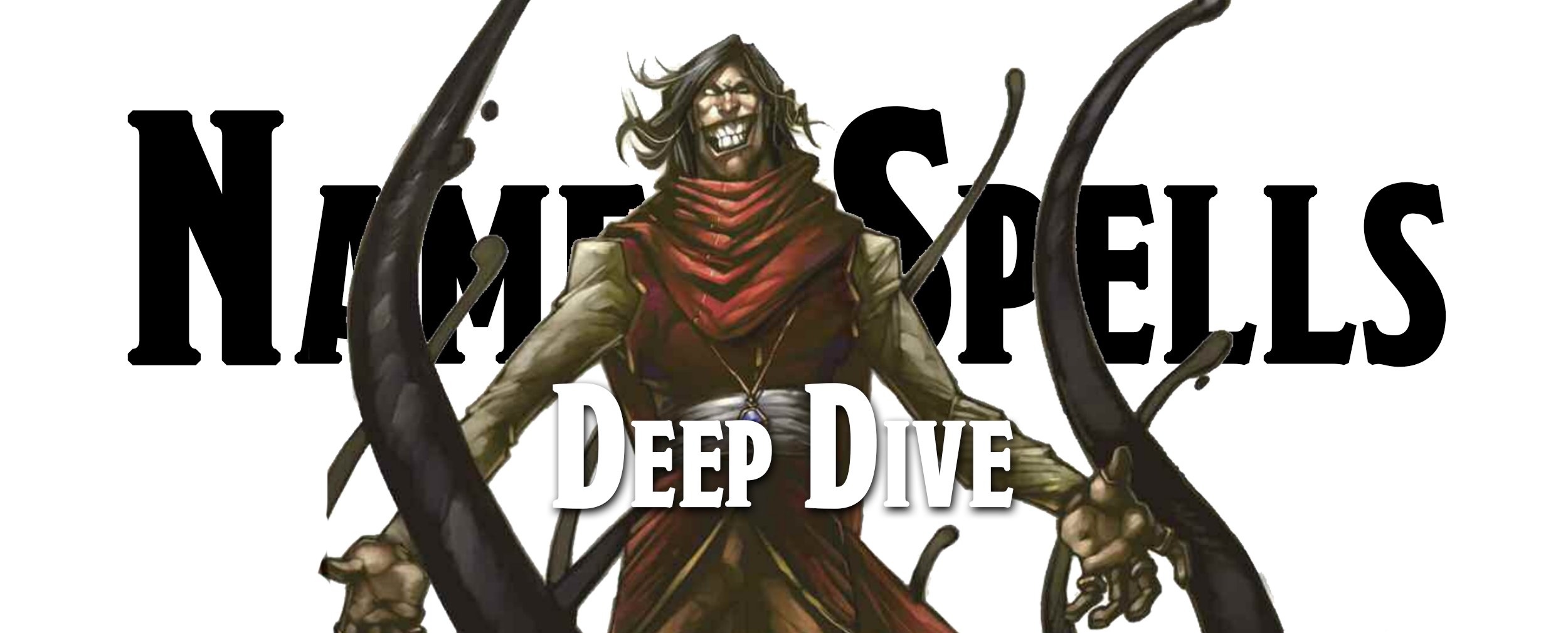Deep Dive - The Lizardfolk
These scaly, emotionless jerks think about food and not much else beyond that. They’ve been around since the beginning of the game, starting as one of the stronger humanoid foes your fighter or magic-user would run into and promptly be eaten by. As the editions progressed the Lizardfolk became a player race and a creature that can create a weapon out of your spine.
In our mythos, Lizardfolk of one sort or another has existed since ancient times. The mythical first king of Athens, Cecrops I, was described as half-man, half-snake, Wahuang, also known as Nuwa, is the mother of Chinese mythology and is described as half-human and half-serpent, and the ancient Egyptians had the patron goddess Wadjet, depicted as a snake-headed woman, a snake, a woman with two snakeheads, or even a snake with a woman's head. In the present day, Lizardfolk abound in TV, cinema, and literature. Dracs, one of the main characters in the book Enemy Mine (1979), is a fighter pilot from the alien race of lizard people at war with Earth, it was later made into a movie starring Dennis Quaid and Louis Gossett Jr back in 1985… it bombed except in the Soviet Union. There’s the Cardassians from Star Trek, Dracoians from Doctor Who, The Lizard - also known as Dr. Curt Connors - an enemy of Spiderman, Cobra Commander from GI Joe…the list goes on and on. There’s even the conspiracy theory believed by millions, that Lizardfolk secretly runs the United States government.
It’s no wonder that Lizardfolk have such a prevalent existence in Dungeons & Dragons when the cultures of ancient and current civilizations are so full of them and their representations. Let’s jump in and see how these creatures have evolved through the generations and maybe you’ll find a soft spot for these man-eating Lizardfolk… or you’ll find out your pet leopard gecko is secretly running the US Commerce Department.
OD&D - Lizardmen
No. Appearing: 10-40
Armor Class: 5
Move: 6”/12”
Hit Dice: 2 + 1
% in Lair: 40%
No. of Attacks: 2 claws / 1 bite
Damage/Attack: 1-3/claw, 1-8/bite
Treasure: D
Greyhawk Supplement, 1974 TSR Inc.
The Lizardfolk make their debut in the Greyhawk Supplement (1974) under the moniker of Lizardmen. While the term Lizardmen is used up until the 3rd edition, we will be referring to them as Lizardfolk from here on out. One of the most important facts about the Lizardfolk we should bring up from this edition is the fact that their artwork actually looks like time was spent drawing it out, and is pretty scary. If we were walking through a swamp and stumbled on one, we’d scream and run away. That’s high praise from us seeing as how the beholder art just makes us pass out from laughter.
As with all creatures in the early editions of the game, the description is brief and all the information we are provided is composed in 3 sentences. What information is provided is pretty sparse and doesn’t provide much of a basis to work off of. The few things we learn is that Lizardfolk are considered to be intelligent, but its referred to as a ‘rude intelligence’ in that they only use that intelligence to make weapons.
After that, we then learn that the favorite dish of the Lizardfolk is human flesh. I’m not sure what it is with all these monsters and their desire for human flesh, but apparently we are incredibly delicious. Not only do Lizardfolk love eating humans, they will capture a group of them from a village and bring them back to their lairs where they will hold large feasts and gorge on our flesh which… feels like a compliment.
The next tidbit of information provided shows that maybe these are really, really special lizards… or maybe the designers of the game just did not know that much about lizards. In this edition, 65% of all Lizardfolk live completely underwater, which is crazy to think about as no other lizard can spend more than 15 minutes under water at a time. It’s also horrifying to think that all those captured humanoids will probably drown before the great feasts of the Lizardfolk, which is a shame because the Lizardfolk have been cooking all day!
Looking at the mechanics of the Lizardfolk, they are humanoid creatures that are much stronger than many of the other creatures in that catergory. Their AC of 5 puts them in the same league as ogres and giants, but their Hit Dice are on the low side making them pretty susceptible to being wiped out in low numbers. Where they thrive is the number of attacks and the amount of damage they can do in a single round. Three attacks is a whole lot of ass kicking in this edition and with the potential to do a maximum of 14 points of damage in a round, the Lizardfolk would make quite a fearsome opponent. These two factors, along with the fact that you will be running into 10-40 of them at a time, make these creatures the party would not want to encounter at lower levels… especially if they were invited over for dinner.
Basic D&D - Lizardfolk
Armor Class: 5
Hit Dice: 2 + 1
Move: 60' (120' swim)
Attacks: 1 weapon
Damage: By weapon + 1
No. Appearing: 2-8
Save As: Fighter: 2
Morale: 12
Treasure Type: D
Alignment: Neutral
XP Value: 25
The Lizardfolk is introduced in the Basic Set (1977) and later makes appearances in the updated Basic Sets that are released in 1981 and 1983. If the Lizardfolks could be stripped down and made even more boring, we aren’t sure how you could do it. The descriptive paragraph is filled with simple sentences that provide less flavor than the original edition and simply describes the Lizardfolk as man-shaped but with a lizard head and a lizard tail. Furthermore, they are considered semi-intelligent and enjoy eating humans in great feasts.
Now, it isn’t all bad for the Lizardfolk in this edition as they are finally shown a little love as they gain a +1 bonus to their damage. Though they no longer have their multiple attacks and instead only have a single weapon attack, so we guess it makes some sense to give them a boost to their damage even if it isn’t as awesome as having three attacks and tearing apart that troublesome magic-user.
This is the first edition of Dungeons & Dragons that players can play as a Lizardfolk thanks to Dragon Magazine #185 (September 1992). In the magazine we are introduced to the Squamous Ones; lizard men, gator men, and the cay-men, all of whom can be used as player characters. These playable reptile creatures all played a role in episode 32 of the Voyage of the Princess Ark, an old series in Dragon Magazine.
Without going down the rabbit hole of experimental player characters and rules, just remember that some races were treated more like classes than as just races. If you choose to play as a Lizardfolk, you would be leveling up in a Lizardfolk class though you could multiclass into actual classes like magic-user or fighter… it was just really difficult and there were a lot of limitations.
With that being said, out of all three of the lizardkin, the gator men are the by far the strongest and intimidating. Their physical attributes were high, they had more hit points, but their mental stats were the lowest out of any of them. After the gator men, in terms of strength, came the lizard men followed by the cay-men. The cay-men were known for being smart, and by that we mean they don’t have a negative bonus to their intelligence, while the lizard men were middle of the road at best between the two others.
In Dragon Magazine #186 (October 1992), we are introduced to another race of playable lizardfolk in the next chapter of the Voyage of the Princess Ark. The chameleon men, also known as the wallara, are pretty weak like the lizard men, but they have a special talent that makes them pretty awesome. The chameleon man can use a Vanish ability, allowing them to disappear from sight, or they could teleport as per the dimension door spell… so long as they passed an Intelligence check which seems a bit mean. Regardless of the intelligence check, that’s a pretty awesome racial ability!
AD&D - Lizardmen
Frequency: Rare
No. Appearing: 10-40
Armor Class: 5 (4)
Move: 6” // 12”
Hit Dice: 2+1
% in Lair: 30%
Treasure Tpe: D
No. of Attacks: 3
Damage/Attack: 1-2/1-2/1-8
Special Attacks: See Below
Special Defenses: Nil
Magic Resistance: Standard
Intelligence: Low (average)
Alignment: Neutral
Size: M (about 7 feet tall)
Psionic Ability: Nil
Monster Manual, 1977 TSR Inc.
The Lizardfolk first appears in the Monster Manual (1977) and things are looking up for this edition. Unlike in Basic D&D, which AD&D ran alongside, we are given a full paragraph about the Lizardfolk, about their lairs, and well… It doesn’t paint the Lizardfolk in a great light… At least they get artwork in this edition and again, it looks pretty good! We suppose you have a choice in these early editions, good art or good lore - not both.
The lizardfolk don’t get a lot of new lore, even though there is more information provided. The books now clarify that they are semi-aquatic and that, while they prefer to live underwater, they live in underwater caves that are not submerged. They love to kill and capture humans, bringing back bodies and slaves to their underwater realms and then holding rude feasts. We aren’t sure what they mean by rude, but we suppose the lizardfolk can be considered rude if they don’t ask permission to eat you first.
If you ever encounter Lizardfolk above the water, they live in small huts and these are the ‘evolved’ Lizardfolk who are more intelligent. These Lizardfolk wield crude weapons like shields, barbed darts, and javelins that they use to attack from range, and then run into the melee with their clubs. There is no mention of a changed diet, so we must assume that they still enjoy the taste of humans and have no problems with attacking villages and eating all the inhabitants.
Fiend Folio, 1981 TSR Inc.
The first variant for the Lizardfolk, the Lizard King, is introduced in 1981 and is found in the Fiend Folio. The Lizard King is a ruler of a large tribe of Lizardfolk and are taller, stronger, more intelligent, and described as more human-like. They could be found near their watery lairs and one of the few ways of actually seeing one was being offered as part of their weekly sacrifice where the Lizard King will then devour you. Every week, the Lizard King would demand two humans to munch on, if those humans weren’t available the Lizard King would then choose four Lizardfolk and eat them… which we feel like creates a bit of an unhealthy working environment.
The next bit of information about the Lizard King is, not only do they have a large tribe of Lizardfolk who bring them humans to eat every week but also they wield a powerful trident that can skewer enemies and deals some real nasty damage. The description goes on to state that there is some sort of magical connection between a Lizard King and their trident, as no one else can use the trident as effectively as the Lizard King and that no one else gains the benefits of using the trident unless you are a Lizard King. This seems like a missed opportunity for some cool lore, but the description comes to an abrupt end, which is a real shame but we aren’t too surprised as the Lizardfolk just doesn’t get any love in these editions.
Fiend Folio, 1981 TSR Inc.
2e - Lizardfolk
Climate/Terrain: Tropical, sub-tropical and temperate swamp
Frequency: Rare
Organization: Tribal
Activity Cycle: Any
Diet: Special
Intelligence: Low (5-7)
Treasure: D
Alignment: Neutral
No. Appearing: 8-15 (1d8+7)
Armor Class: 5
Movement: 6, Sw 12
Hit Dice: 2+1
THAC0: 19
No. of Attacks: 3
Damage/Attack: 1-2/1-2/1-6
Special Attacks: Nil
Special Defenses: Nil
Magic Resistance: Nil
Size: M (7’ tall)
Morale: 14
XP Value: 65, Patrol Leader 65, Subleader 120, War leader 270, Shaman (3rd) 175, Shaman (5th) 650, Shaman (7th) 975.
Monstrous Compendium Volume One, 1989 TSR Inc.
The Lizardfolk made their second edition debut in the Monstrous Compendium Volume One (1989) and then reprinted in the Monstrous Manual (1993). In typical 2e fashion, we are given a lot more lore about the Lizardfolk though a lot of the information is just rehashed from the previous edition but with more colorful language. Also, their artwork in the Monstrous Compendium looks… fine? They look a bit like they ran into the wall and broke their snout, but it's passable.
Much like before, the Lizardfolk are tall, strong, and have below-average intelligence. They don’t really use weapons unless they are ‘advanced’ Lizardfolk and like to live next to the water or under the water in their caves. A key difference is that now they are omnivores and that they are only ‘likely to prefer human flesh to other foods.’ This is of great relief to anyone who isn’t a human as now, maybe, just maybe, you can interact with them without them carrying you off to their cave for more rude feasts.
Monstrous Manual, 1993 TSR Inc.
What other information is pretty interesting and helps to flesh out this monster. When fighting, they aren’t great at tactics and typically just rush in hoping to overpower their opponents. To make matters worse, if they are hungry, there is a chance they will stop for a quick snack of dead human on the battlefield, allowing their quarry to retreat, regroup and reinforce. They are distracted by shiny things too, and we have decided to skip past the easy blonde joke here.
Despite their lack of coordination or tactics, they do have several tiers within their society like shamans, priests, patrol leaders, and chieftains. The shamans and priests have additional hit points and have access to priest abilities like spellcasting. Patrol leaders are even beefier and are used as the bodyguards of the Lizard King who is at the top of the food chain and will lead tribes up to 150 Lizardfolk strong. Of course, if the Lizard King doesn’t get their weekly sacrifice of two people, they eat four Lizardfolk which it specifies is their bodyguard… which seems like a bad idea, why not eat the peasant Lizardfolks? You have way more commoners than bodyguards.
We also start to get a little better idea of the physiology of these creatures as they can vary in color from green to brown to gray. Tails can be up to 4 feet long and, while they cannot be used to grab any sort of object, it does seem like its a missed opportunity for a tail attack. Like all lizards, Lizardfiolk are hatched from eggs but we strongly encourage you to not eat the eggs as they are described as bitter. The last thing we learn is the question burning on everyone’s mind how do you figure out if the Lizardfolk you’ve been hitting on all night is male or female? The answer is: You don’t know unless you ask. We recommend asking from a safe distance with lots of blonde, dead human bodies in the way.
The Complete Spacefarer’s Handbook, 1992 TSR Inc.
If you wanted to play as a Lizardfolk, you are in luck as the Spelljammer campaign setting provides character information in The Complete Spacefarer's Handbook (1992). What is interesting is that if you wish to play as a Lizardfolk, you lose some of the natural abilities and flaws that the normal Lizardfolk has, though you do get a few bonuses. You don’t gain a bonus to your Strength, on the other hand, you don’t get a penalty to your Intelligence, which is nice. You have natural armor, you can wield a shield and you can only wear armor that would reduce your AC below 5, like plate mail. Of course, getting custom armor will cost you twice as much then for a human as we can only assume blacksmiths find it hard to add in a tailpiece for you… or they don’t like your kind because they ate their brother. One of those.
Speaking of eating people, you no longer have a bite attack. Instead, you are given a tail attack which is… well, we support having a tail attack but we guess biting people is considered uncivilized. The last bit of awesomeness for your Lizardfolk character is you now have infravision which helps you see in the dark, which is the first time this controversy will come up. Apparently, in the Forgotten Realms specific lore, Lizardfolk has darkvision but they lose it the moment any information is talked about in a setting neutral book.
The Lizardfolk and their information are further refined as a playable character race in The Complete Book of Humanoids (1993). It is here that you get the first real information on how a Lizardfolk should be played when you decide that being an elf just won’t do, why be the eaten when you could be the eater? Lizardfolk have a totally different mindset that other humanoid types, looking at things in a very black and white, food or not food type of way. Civilization as a concept is beyond them, so traveling to and spending time in a city will be a foreign and overwhelming experience for them. Fiercely independent, they might not fit into the party setting very well but can be forgiven when they wipe out a horde of kobolds by themselves. They are still extremely brutal and cruel on the battlefield, so sometimes it may just be best to get out of the way and watch the bodies fly. Another reason to back away is that when shiny stuff or dead bodies appear in battle, Lizardfolk must make a successful Wisdom save or get distracted, and even stop for a little snack of halfling. Considering most combat results in someone or something dying, be ready with those Wisdom checks.
Furthermore, we learn that for a Lizardfolk, skincare is an essential part of your adventuring day and you must moisturize every day or you start getting sick and dehydrated. If you spend too long without submerging your body in water, you dry out and die. On the flip side, you start with two weapon proficiencies, which means you are the advanced Lizardfolk and not just the hilly-billy Lizardfolk who don’t use weapons and have no intelligence.
Dragon #268, 2000 TSR Inc.
More lizard-kin are introduced in this edition, though many of them claim to have no relationship to the Lizardfolk. We are introduced to agrutha, crocodillians, varanids, geckonids, tokay and the iguanid in the Dragon Magazine #268 (2000) though none bear may resemblances to the Lizardfolk but rather are considered subspecies or apart from them. One of the few kin to actually be related to the Lizardfolk are the Gator Men from the Monstrous Compendium Mystara Appendix (1994) and a horrifying secret is exposed. The Gator Men were once Lizardfolk that were magically experimented on by a wizard who was trying to give them alligator properties. Some of the wizard’s Gator Man prototypes escaped into a nearby swamp and quickly reproduced, wiping out all other predators in their area. Gator Men hate Lizardfolk and will do everything in their power to destroy and kill every last one of them if they learn of a Lizardfolk tribe.
3e/3.5e - Lizardfolk
Medium Humanoid (Reptilian)
Initiative +0
HP 2d8+2 (11 hp)
Armor Class 15 (+5 Natural) or 17 (+5 natural, +2 heavy shield), touch 10, flat-footed 15 07 17
Speed 30 ft. (6 squares)
Base Attack/Grapple +1/+2
Attacks: Claw +2 melee (1d4+1) or club +2 melee (1d6+1) or javelin +1 ranged (1d6+1)
Full Attack: 2 claws +2 melee (1d4+1) and bite +0 melee (1d4); or club +2 melee (1d6+1) and bite +0 melee (1d4); or javelin +1 ranged (1d6+1)
Space/Reach: 5ft./5 ft.
Special Attacks: None
Special Qualities: Hold breath
Saves: Fort +1, Ref +43 Will +0
Abilities: Str 13, Dex 10, Con 13, Int 9, Wis 10, Cha 10
Skills: Balance +4, Jump +5, Swim +2
Feats: Multiattack
Climate/Terrain: Temerate Marshes
Orgnization: Gangs (2-3), Band (6-10 plus 50% noncombatants plus 1 leader of 3rd-6th level), or tribe (30-60 plus 2 lieutenants of 3rd-6th level and 1 leader of 4th-10th level)
Challenge Rating: 1
Treasure: 50% coins; 50 % goods: 50% items
Alignment: Usually neutral
Advancement: By character class
Level Adjustment: +1
Monster Manual, 2003 WotC
The Lizardfolk makes its third edition debut in the Monster Manual (2000/2003) and is the first edition where the term Lizardfolk is used, replacing the term Lizardmen permanently. To quickly cover the normal parts of our scaly friends; they are organized into tribes, they are a cruel and vicious opponent on the battlefield, and they still live in swamps and marshes. You may notice the fact that their favorite meal is you is not on that list, that's because the Lizardfolk will eat anything and it's only a malicious rumor that they prize human flesh above all else, they just happen to kill a lot of humans and eat them. They’d eat anyone, they aren’t picky. Another change is that they no longer speak Lizardfolk but rather draconic as they now can be found in the employ of dragons.
Societal structure is detailed just a little bit more, giving a tiny more depth to the creature. A tribe exists to eat and perpetuate, and they will do whatever is necessary to make sure these needs are met. Sure, Lizardfolk can hunt and fish like other humanoid races, but when there is a village of humans nearby, you can bet they will be sending out raiding parties and having grilled human for dinner whenever possible. This primitive need for survival has tribes uniting to fight a common foe, even if that foe is another, larger Lizardfolk tribe. It will occasionally drive them to serve more powerful creatures such as dragons, cause in the mind of the Lizardfolk, it is better to serve than to die.
Monster Manual 3, 2003 WotC
The tribe is set up in a very simple manner - the strong rule the weak, and it’s a man’s world in the Lizardfolk kingdom. This stays with the concept of the powerful rule and the weak serve. The shaman is still alive and well in the Lizardfolk society, acting as a councilor for those in charge, providing insight and knowledge, we expect most of the insight revolves around food. The shaman, along with the rest of the Lizardfolk, now has a deity to pray to, as we are introduced to the patron deity of Lizardfolk, Semuanya. Not surprisingly, Semunya’s primary focus is on the survival and propagation of its charges, once again sticking with the common theme of the Lizardfolk; eat, propagate, and eat some more.
Monster Manual 3, 2003 WotC
The Lizardfolk appears as a player character race for the Forgotten Realms setting in the Races of Faerûn (2003) and again, they gain darkvision while existing in the Forgotten Realms. Beyond gaining the ability to make three attacks with their claws and bite, there is nothing new when it comes to being a Lizardfolk as a player character.
The next month in April we are introduced to the Monster Manual 3 (2003) and with it, two new types of Lizardfolk come to ruin everyone’s day. The Blackscale Lizardfolk is a massive brute of a Lizardfolk who specializes in pummeling you into the ground and then eating the tenderized meat. Blackscales are large and their presence makes even the tallest Lizardfolk look small as they are typically around 9 feet tall as opposed to the 7 foot Lizardfolk. After the Blackscales are the Poison Dusk Lizardfolk who go in the opposite direction from their Lizardfolk ancestors and are tiny, reaching a max of 5 feet tall and 50 pounds. They specialize in being sneaky, attacking from range, and using poison to bring down larger opponents for the purpose of dinner.
Serpent Kingdoms, 2004 WotC
As we are always excited to check out new old rulebooks we’ve never used before, it was exciting to find out that Lizardfolk have their own chapter in the Serpent Kingdoms (2004), though it is centric to the Forgotten Realms setting. There we find out more about asabis, firenewts, khaastas, troglodytes, and trens, but it is the Lizard King and Queen that we were excited about. These creatures are now half-Lizardfolk, half-fiend. A Lizard King resembles a common Lizardfolk, but gets to be even scarier by having demonic features, such as glowing red eyes, extra-long arms, long fangs, or additional scaly frills. They are despised in the Faerun since, not surprisingly, they view humans, elves, dwarves, and almost all other humanoid races as food, not as allies or neighbors. Remember how we’ve always said that they Lizardfolk can be cruel and mean? Well, the Lizard King combines the worst traits of Lizardfolk and demons, making them brutal overlords of a tribe, but their tribe means everything to them and they take great care of its members. They use their vision, intelligence and sheer force of will that comes with being half-fiend, to transform a simple savage tribe into a stable civilization that can endure for many generations. We are also provided information about some of the poisons Lizardfolk use like the blue frog paste, which sounds like a powerful form of LSD, but in fact, it is a toxic oil that can be applied to weapons and causes paralysis. The second is the rather boringly named sleep poison, which renders the victim unconscious for a few hours.
Dragon Magazine #335 (September 2005) brings us the ecology of the Lizardfolk, unfortunately, the article is a combination of all the previous editions information, presented in a colorful description, and provides only a few new pieces of information. Religion plays a much more important part in the lore and creation of the Lizardfolk, as the article opens with a section on their goddess, Semunya and the origins of the Lizardfolk. Semuanya was a primitive lesser god who thought only about food and survival while her mate, Kecuala, was an intelligent creature that spent its time doing little physically, as it was trapped in its own philosophical thoughts about the world. One day, Kecuala split itself into two creatures, one male and one female, allowing it to put into action the deep thinking that it had been doing all these years. These two Kecualas were the first Lizardfolk and Semunya took the initiative with them and set them up in an environment where they could hunt and multiply, holding out hope that Kecuala would finally stop thinking so much, merge back into one being, and rejoin Semunya.
Building on the tribal/communal system of the Lizardfolk, we do find out that each tribe has a community-style hatchery where all the eggs are kept until little lizard children erupt from their shells. Lizardfolk reach maturity by 2 years of age, skipping those awkward teenage years and for the brief two years of being young, they are raised by the tribe as a whole and not by individual parents.
Monster Manual IV, 2006 WotC
The last of the Lizardfolks were introduced in the Monster Manual IV (2006) where we are introduced to the Dark Talon tribe of Lizardfolk and provided an example lair for them. They are similar to the Lizardfolk but have been toughened by alchemical infusions of black dragon blood and seek to take over and control the lands of everyone else. They are brutal, mean and vicious but they don’t provide much information on the whole of the Lizardfolk race but rather how their specific tribe operates but, that doesn’t mean there isn’t anything in there to learn. We learned a very important lesson, if you find a massive wasp the size of a horse, you can totally ride on it with a massive lance. Yup, the Dark Talon tribe has a small troop of Wasp Riders who wield lances and charge into battle on their battle wasps. We aren’t sure that the riders are really needed as seeing wasps large enough to be ridden by Lizardfolks already scares us more than a Lizardfolk.
4e - Lizardfolk
Greenscale Hunter - Level 4 Skirmisher
Medium natural humanoid (reptile) / XP 175
Initiative +6 / Senses Perception +8
HP 54; Bloodied 27
AC 17; Fortitude 15, Reflex 14, Will 13
Speed 6 (swamp walk)
Spear (standard; at-will) ✦ Weapon
+9 vs. AC; 1d8+3 damage
Sidestep Attack (standard; at will) ✦ Weapon
The lizardfolk shifts and make a melee basic attack.
Alignment Unaligned / Languages Draconic
Skills Athletics +10, Nature +8
Str 17(+5) | Dex 15 (+4) | Wis 12 (+3) | Con 14 (+4) | Int 8 (+1) | Cha 8 (+1)
Equipment light shield, spear
The Lizardfolk is introduced in the Monster Manual (2008) and we are provided with stat blocks for different roles that a Lizardfolk could be in a tribe like a shaman or a hunter, as well as information about the Blackscales, the massive brutes of Lizardfolk. While the lore doesn’t go very deep, we at least have some pretty great art, especially when compared to the previous Monster Manuals, so 4e has that going for it at least.
Monster Manual, 2008 WotC
The first type of Lizardfolk presented are the smaller and more common Greenscales who are, while not of the highest intelligence, are still considered the intelligent and advanced Lizardfolks who become shamans and leaders of their tribe. The next type are the Blackscales who go around smashing and pulverizing creatures and are often intermingled into the Greenscale tribe. Occasionally the Blackscales will be part of an opposing tribe, but the text reveals that Blackscales just aren’t smart enough to be the leader and, while Lizardfolk believe the strongest should lead, that doesn’t mean that the Lizardfolk are willing to trust a dumb brute with the welfare of their tribe.
There are also a few tidbits of lore that you can pick up on in their description like halflings are too small to bother eating, since they are the preferred humanoid trading partner for the Lizardfolk. Also, that Lizardfolk would occasionally serve dragons, though more often than not they would have servitors of their own like behemoths, crocodiles, and drakes. And finally, that Lizardfolk do not worship any gods but rather they elevate their tribal leader into a living deity. This Lizardfolk becomes the King Lizard and is rumored to have been tainted by primordial or demonic forces to make them so unnaturally strong and powerful.
The next group of Lizardfolk is brought out of the swamps in the Monster Manual 2 (2009) and they are known as the Poisonscales and, as their name might suggest, they really like poisoning creatures. The Poisonscales are a type of Lizardfolk that is less strong and healthy, though far more intelligent and are quite affluent with traps, ambushes, and using their naturally produced poisons to kill creatures and then eat them. These Lizardfolk come in a variety of roles from the magus that can hurl poison magic at their enemies, to the Poisonscale Collector that has the all-important task of gathering food and the plants the Lizardfolk eat to exude their poison, to the poisonless Poisonscales Myrmidons who cannot produce poison but makes up for it with being stronger and having thicker hides.
The Poisonscales are a slightly weaker group of Lizardfolks, which is hard to believe as the Greenscales are so low powered to begin with. The only true threat coming from the Lizardfolks in this edition is that a tribe consists of over a hundred of them, and when its just you and your 3 best friends wandering the swamps and being filled with tasty human meat, well… maybe you can kill enough of the Lizardfolk so they don’t have to share their meal with others in the tribe.
Monster Manual 2, 2009 WotC
5e - Lizardfolk
Medium humanoid (lizardfolk), neutral
Armor Class 15 (natural armor, shield)
Hit Points 22 (4d8 + 4)
Speed 30 ft., swim 30 ft.
STR 15 (+2) | DEX 10 (+0) | CON 13 (+1 ) | INT 7 (-2) | WIS 12 (+1) | CHA 7 (-2)
Skills Perception +3, Stealth +4, Survival +5
Senses passive Perception 13
Languages Draconic
Challenge 1/2 (100 XP)
Hold Breath. The lizardfolk can hold its breath for 15 minutes.
Multiattack. The lizardfolk makes two melee attacks, each one with a different weapon.
Bite. Melee Weapon Attack: +4 to hit, reach 5 ft., one target. Hit: 5 (1d6 + 2) piercing damage.
Heavy Club. Melee Weapon Attack: +4 to hit, reach 5 ft., one target. Hit: 5 (1d6 + 2) bludgeoning damage.
Javelin. Melee or Ranged Weapon Attack: +4 to hit, reach 5 ft. or range 30/120 ft., one target. Hit: 5 (1d6 + 2) piercing damage.
Spiked Shield. Melee Weapon Attack: +4 to hit, reach 5 ft., one target. Hit: 5 (1d6 + 2) piercing damage
Monster Manual, 2014 WotC
Lizardfolk can be found in the Monster Manual (2014) and with it comes a nice, chunky bit of lore on these Lizardfolk, though it mostly repeats the previous edition. One thing that has been missing the last few editions is finally back, and that’s that they have a hankering for human flesh, even if they are omnivores. It’s no longer considered a mean and unfounded rumor that they like the taste of you, though the lore doesn’t stop at them eating you. These Lizardfolk are willing to forge alliances with others like humans, halflings, dwarves, and more, once they have these alliances made they are fiercely loyal to the other ‘tribe’ and we hope that means they won’t eat you at that point.
Though one shouldn’t expect to have too many interactions with Lizardfolk as these creatures are fiercely xenophobic, hunting and killing anyone who trespasses on their territory. They rarely leave their territory, as they might become the hunted as opposed to the hunter, and that is something they actively dislike. Though, that isn’t to say they never leave their territory, if a dragon, most likely a black dragon, shows up in their swamp, the Lizardfolk will begin offering it gifts and immediately begin serving the dragon. The dragon may be a nice ruler, watching over its Lizardfolk with an eye to protection… or they may be horrible and send out raids of Lizardfolk to help it build up its treasure hoard.
Now, let’s say you get eaten by the Lizardfolk because you were thinking you could walk on their territory and set up a trade agreement and they thought you’d taste better than the terms you were offering. You might, in this situation, be worried that your bones and other inedible bits won’t be treated with the proper respect you think they should be treated, but don’t worry as the Lizardfolk now love to craft crude jewelry and tools from bones of their meal! Lizardfolk will often craft clubs, shields, darts, and other weapons from the bones of creatures they have killed, seeing no point in good materials going to waste just because the previous inhabitant of those body parts are no longer using them. Really, they are just being responsible hunters and using every part of the kill!
Volo’s Guide to Monsters, 2016 WotC
In Volo’s Guide to Monsters (2016), the Lizardfolk is presented as a playable race, along with other favorites such as the goblin and kobold. One of the best parts about the Lizardfolk being made a playable race is that we are given an in-depth look into the essence of being a Lizardfolk and how such strange creatures act and think. A Lizardfolk’s mindset is described as alien, but not in the sense that they are from some distance world from the Spelljammer setting, instead, they are described as cold and calculating with few emotions as we would know them. This doesn’t mean that you should roleplay your new Lizardfolk fighter as some hissing jerk, but as a character that genuinely doesn’t understand why other creatures are horrified when they want to fire up the campfire and celebrate the life of a fallen comrade by roasting and eating their corpse.
The existence of a Lizardfolk is centered on doing things that make them feel good and avoiding things that would cause them pain or discomfort. A Lizardfolk doesn’t have emotions that control its fight or flight reflex but instead reacts accordingly to the situation. If it is going against a powerful opponent, it doesn’t run away in fear but rather realizes that the opponent is best to leave alone due to how fearsome it is. If the Lizardfolk finds a magic item that provides a great benefit, it doesn’t gain pleasure from that item but realizes it makes life easier and must protect this magic item so others don’t take it away. The mindset of a Lizardfolk is assigning traits to creatures and objects and reacting accordingly to that trait as they don’t hold grudges or allow rage to overcome them.
Ghosts of Saltmarsh, 2019 WotC
The last book we will look at for 5th edition is the Ghosts of Saltmarsh (2019), though it originally came out in 1982 for AD&D, and in it is an adventure focused around these creatures. In the adventure, a party of adventurers is tasked with going to a Lizardfolk lair and investigating the Lizardfolk and seeing if they are responsible for the recent attacks on the city. This is a roleplaying heavy adventure and allows a group of adventurers to explore the lair of Lizardfolks without using violence to get a peek into every room. This adventure provides helpful tips about the mindset of a Lizardfolk and helps to explain that the way they communicate can be quite unsettling or unnerving not used to such an alien mind.
Even though they have been around since the beginning of Dungeons & Dragons, and that they have such an overwhelming presence in our legends, the Lizardfolk still have a lot of untapped potential. While they appear in a wide variety of adventures and core rulebooks, they rarely change and when they do so it is incremental. Other humanoids that have been around since the beginning have seen endless amounts of time and effort put into their backgrounds, the Lizardfolk haven’t been so lucky. They are still the same highly mistrusted brutes that they were before, and maybe that’s all they will ever be as everyone needs a monster to fight. Maybe one day we will see new sub-races or more development on their story as well as their culture. We certainly hope so, as the Lizardfolk deserves more recognition than the few adventures and lore that they currently have.
Got something you’d like to see a Deep Dive on?
Let us know in the comments below!
If you enjoy our Deep Dive series consider
supporting us on Patreon and following us on Twitter!











